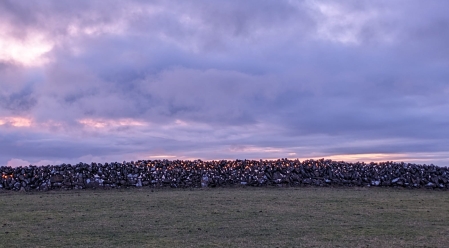Two years ago, we walked a troubled league near Thin Places with Kerri ní Dochartaigh picking up feathers and stones because they were there so fucking perfect: exemplars of their kind. You canna keep a poet in a box, they have to walk about this dark world and wide looking sideways at feathers and stones and the beating heart. The rest of us don't even notice the feathers, let alone reflect on how form and function collide. The rest of us shear away from Thin Places where real life steps through those rents in the fabric of the universe to confront the other.
But on this All Soul’s Night there is
no respite from the keening of the wind.
I would not be amazed if every corpse came risen
from the graveyard to join in exaltation with the gale,
a cacophony of bone imploring sky for judgement
and release from being the conscience of the town. src
More? Canongate have brought out a continuation of This Observer's life
Cacophony of Bone which starts between Solstice and Christmas 2019 when Kerri and her feller M, bunk off from Derry to hunker down in a micro-cottage on a now barely visible defunct railway in Co Westmeath. Their rough haven in a sea of troubles is about halfway between Lough Derravarragh and Granard Co Longford. The book is dedicated to
Ann Lovett of Granard [and see
Paula Meehan stanza above] and Kerri often swims in wild Derravarragh with the Children of Lír and in-real-life wild things: feathered and finned. With hindsight it was an awkward time to start a year of living together up a laneway surrounded by bogs. Even as their van pulled into the yard, SARS-CoV2 was scything through Wuhan and was about to change what everybody could and couldn't do. In another life (same planet) my mother died, in the fullness of her 99 years, three weeks after Kerri and M had their first breakfast in their new home. At her memorial service in February 2020, rumours of Covid were drubbing louder and that was the last time I was in England until the
end of August this year.
The title Cacophony of Bone is an acknowledgment of the litter of skeletal remains that are scattered about the fields and ditches . . . if you pay attention and care to look. Kerri has a collection of these skulls and pelvises which rub scapulae with the feathers and perfick stones that can be found on beaches - when we're permitted to travel from bogland to shoreline. As well as wild-swimming and bogland walks, Kerri records the process of final revisions and proofing her first book aka, in the book's Victorian convention of reference by initials, "TP". In one sense this choice is legitimate - it's a journal! - in another it's exclusionary to the reader. JH is John "Derry's Own" Hume who died, and is here fondly memorialized, in August of the year of marking time - that's okay. M is Kerri's life-partner, unless it's referring to M's business partner M. Other writers, incl Manchán Magan [prev] are mostly credited in full, while personal pals and supporters are reduced to a letter grade. I guess they know who they are, and it's none of my biz.
I had a swipe at the word unimaginable in my review of TP. CoB's over-used word is surreal. It can almost always be replaced with surprising, unusual, peculiar and is rarely used in its dictionary sense of the intersection of dreams and the unconscious with reality. Now, authors and especially poets can adopt a Humpty-Dumpty (When I use a word it means just what I choose it to mean - neither more nor less) attitude to language but loose massaging of meaning make the writing flabby.
Two particular and personal celebrations twine through this journey-in-place: i) getting on the waggon after years of crabby hung-over mornings and ii) getting with child, which brings its own crabby mornings. I used the f-word in the first sentence of this Blob, which is not something I do a lot. But in this piece it's not out of place? That's how babies are made and, after surreal, it's the most over-used adjective in Cacophony of Bones.
But leave aside the carp! Read this book for its lyrical ruminations on nature and our place there. Kerri ní D is mind-open to whatever the world throws at her; she pays attention and is grateful for small-small things. Growing lettuce in her own garden becomes a source of wonder and accomplishment; waking to find a moth on her pillow is a message from the old gods; just by being there, by bearing witness, she soothes the troubled breast. Hers, but ours too by proxy.
Breathe through the heats of our desire
Thy coolness and Thy balm;
Let sense be dumb, let flesh retire;
Speak through the earthquake, wind, and fire,
O still, small voice of calm.
src
sing it
And the child? Reader, she delivered him!























